A hothouse hybrid with a beautiful name and a bountiful harvest - “Emerald Earrings” cucumbers
In the northern regions of our country, heat-loving crops are grown only in greenhouses. Closed structures provide plants with optimal temperatures and protect them from adverse environmental conditions. This method also has a drawback - bee-pollinated varieties require artificial transfer of pollen and set fewer fruits. These plants include most varieties of cucumbers.
But there are exceptions among them. Thanks to modern selection, parthenocarpic cucumbers have appeared on the markets, which independently form bouquet-type ovaries and have only female inflorescences. A striking representative of such cucumbers is the Emerald Earrings hybrid. Is this crop only good for its ability to self-pollinate and what else will it please gardeners - read on.
Description
Cucumbers Emerald earrings are a hybrid bred by domestic breeders. Its originator is a group of agronomists from the Poisk company.
To the state register culture introduced in 2011. Since then, it has gained popularity among domestic and foreign gardeners.
Note! Seeds collected from your own harvest of Emerald Earrings are not suitable for cultivation. They produce plants not with hybrid, but with parental characteristics.
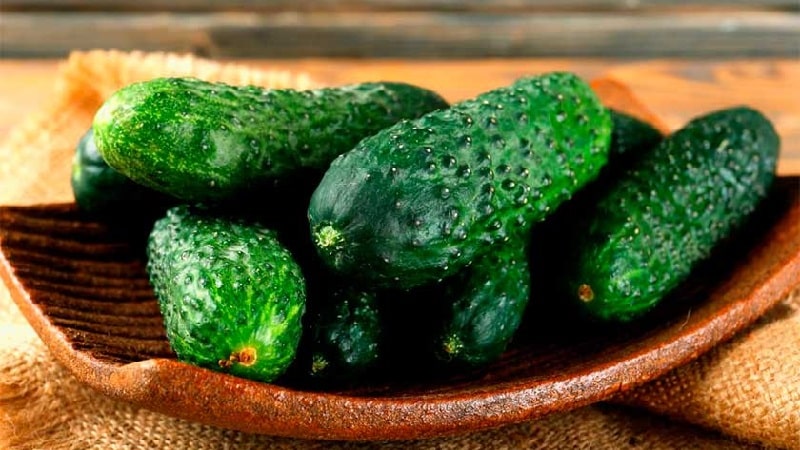
Distinctive features
The main feature of Emerald earrings is considered to be bouquet arrangement of ovaries. This is what ensures high plant productivity.
Only female inflorescences form on the bushes. With proper care, they all set fruit. The main distinguishing feature of the hybrid is the ability to self-pollinate. This greatly simplifies its cultivation in open ground and in a greenhouse.
The greenies themselves are medium in size and dark green in color. They taste sweet, juicy and crispy.
Hybrid is immune to major diseases Solanaceae This reduces the need to treat it with chemicals.
Beneficial features
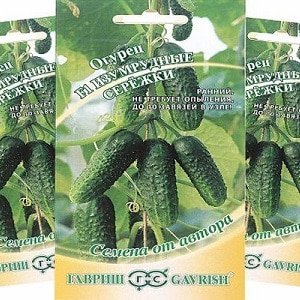 Cucumbers consist of 95% water and are considered dietary products - per 100 g of pulp there are only 14 g of kcal, 0.8 g of protein, 2.4 g of carbohydrates and 0.1 g of fat.
Cucumbers consist of 95% water and are considered dietary products - per 100 g of pulp there are only 14 g of kcal, 0.8 g of protein, 2.4 g of carbohydrates and 0.1 g of fat.
Contains a group of vitamins: A, C, B and K. There is also a group of minerals present in cucumbers, these include: sodium, potassium, copper, calcium, magnesium.
Such components have a beneficial effect on the condition kidneys and liver, skin and hair, heart and blood vessels. They remove harmful substances from the body: waste, toxins, bad cholesterol and free radicals.
General characteristics
Description of Emerald earrings will impress even the most demanding gardeners. This The hybrid is easy to care for and has high yields.. See the table for more details.
| Options | Indicators |
| Bush type | Indeterminate. Forms long lashes. The leaves are large and bright green. Branching is average. All inflorescences are female. The ovaries are formed according to the bouquet type. Up to 12 ovaries are formed in one leaf axil. |
| Fruit | Medium size. The maximum length of one cucumber varies between 10-12 cm, with a transverse diameter of 4 cm. The weight of the fruit is equal to 100-200 g. The shape of cucumbers is flattened oval. The color is dark green, with darker spots and light stripes.Cucumbers are covered with sharp white thorns. They have a sweetish taste and a rich, fresh aroma. The flesh is tender and crispy. The skin is thin but durable. The seeds are small. |
| Productivity | High. From 1 sq. 15-17 kg of crop is harvested. |
| Ripening time | Mid-season. The fruits are ready for harvesting already 40 days after sowing the seeds. The fruiting period lasts no more than one and a half months. |
| Growing method | Suitable for cultivation in open and protected ground. In the second case, productivity indicators are higher. |
| Transportability | High. The fruits are stored for more than three weeks and do not wrinkle during transportation. |
| Disease resistance | It is immune to powdery mildew, cucumber mosaic, peronosporosis, and root rot. |
How to grow your own
Cucumbers Emerald catkins are grown in a greenhouse and in open ground. In protected soil, the harvest is more abundant.
In any case, the beds for planting need to be prepared. This is done differently in a greenhouse and in open ground.
Before planting, the walls, ceiling and floor of the greenhouse are treated with copper sulfate. If cucumbers previously grew in the beds, then the top layer of soil is changed.
In the open ground It is important to choose the right area of the garden. It should be semi-shaded. If there is no such place in the garden, then it is created artificially by fencing the beds on both sides with tall crops.

Further actions:
- The soil is dug up to the depth of a spade bayonet. It is cleaned of plant residues. Fertilizers are applied to the soil at the rate of 6 kg of manure or humus per 1 square meter. m.
- If the acidity of the soil is increased, it is reduced with dry lime or ash. To loosen the soil, river sand is added to it.
- In spring, the soil is leveled with a rake and cleared of weeds. For every 1 sq.m add 25 g of superphosphate and ammonium nitrate. The beds are watered with a hot solution of copper sulfate, prepared from a bucket of water and 1 tbsp. l. vitriol.
- A month before picking cucumbers, holes are prepared for a permanent place. For 1 sq. m place up to four plants. Use a 50x40 pattern.
- 1 tbsp is poured into each hole. l ash or long-acting granular fertilizers. 3 days before picking the plants, chicken manure diluted 1:10 is poured into it.
To reduce the amount of feedingthat will have to be added during the season, some gardeners place nutritious organic compounds directly into the holes. To do this, add a 5 cm layer of rotted manure or humus to the bottom of each depression. The same layer of garden soil or peat is laid on top. The components are mixed. The rest of the hole is filled with ordinary soil.
The holes are watered 3 times a week and cleared of weeds so that all the fertilizers have time to dissolve in the soil and make it nutritious.
Advice. To make the soil more fertile, last year's cucumber tops or the remains of other cultivated plants are buried in it in the fall. By spring they will rot and turn into a nutrient substrate.
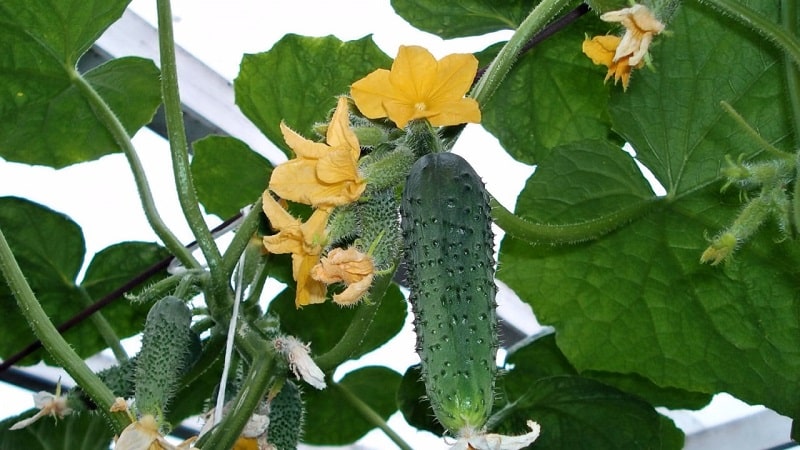
Landing
Emerald catkins cucumbers are grown in seedlings and without seedlings. In both cases planting material required proper preparation.
Often, hybrid seeds are coated or glazed in a factory. These seeds are covered with a layer of nutrients and are colored red or orange. Processing instructions are indicated on the packaging.
Factory-treated seeds do not require disinfection or treatment with growth stimulants. Many gardeners warm them up and germinate them before planting.
If the manufacturer has not prepared the seeds for planting, then this is done at home. The process includes several stages:
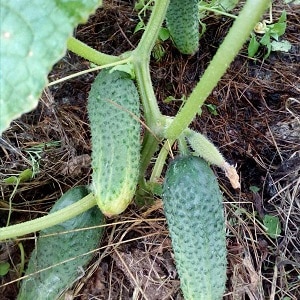 The seeds are sorted. Dense specimens without unevenness or dark spots are suitable for planting.
The seeds are sorted. Dense specimens without unevenness or dark spots are suitable for planting.- The calibrated planting material is put back into the packaging or in a fabric bag and placed on or next to the battery. This is done 30 days before planting. Warmed planting material germinates faster.
- Then seed growth is stimulated. They are soaked for 24 hours in a growth stimulator. They use both purchased products (“Epin”, “Potassium Humate”) and homemade preparations, for example, a solution of 1 teaspoon of honey in a glass of water.
- The seeds are germinated. To do this, they are wrapped in damp cloth and placed in a warm place. The material is moistened with warm water as it dries. After 2-3 days, the seeds should sprout.
- The bent planting material is hardened. It is placed in the refrigerator for 2-3 days.
Note! When growing cucumbers in seedlings, the first harvest will appear faster.
By seed method
By seed method Cucumbers are grown in the southern regions of our country. In this case, the seeds are sown directly into the ground.
Sowing seeds is possible when the soil warms up to a temperature of +15 °C, at a depth of 15 cm. The time to start growing cucumbers depends on the climate of the region:
- in open ground without film - end of May;
- in open ground under film - mid-May;
- in unheated greenhouses - early May or late April.
Note! Practice shows that when growing Emerald earrings in a greenhouse, the yield will be higher.
Before sowing the seeds, water the holes with warm water, using 1 liter of liquid for each. One seed is sown in each hole to a depth of 4 cm. They are sprinkled with soil, which is slightly compacted.
In open ground, crops are covered with film. It is opened slightly for ventilation every day. When the first shoots appear, the duration of the procedures is gradually increased. After another two weeks, the film is completely removed.

Seedling method
The seedling method is used in all regions of our country. It will allow you to get stronger plants and an earlier harvest.
A universal seedling soil mixture is suitable for cucumbers. Many gardeners prefer to prepare the soil themselves. To do this, mix the nutrient substrate and base in equal proportions, and add half a portion of baking powder to them:
- base: garden soil, turf, black soil;
- nutrient substrate: peat, humus;
- baking powder: sawdust, sand, crushed coconut substrate.
You will need drainage for seedlings. They use crushed ceramics, expanded clay and brick, small crushed stone, and shell rock.
The soil and drainage are disinfected. They are calcined in the oven or poured with a dark pink solution of potassium permanganate.
Advice. To saturate the soil with nutrients, ash and nitrophoska are added to it.
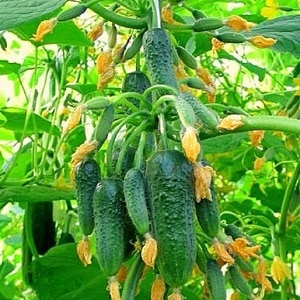 Cucumber seeds are sown in individual containers. Plastic pots, disposable cups, cut-off bottles, and peat containers are suitable. It is important to ensure that there are drainage holes at the bottom of the container.
Cucumber seeds are sown in individual containers. Plastic pots, disposable cups, cut-off bottles, and peat containers are suitable. It is important to ensure that there are drainage holes at the bottom of the container.
Drainage is poured into the bottom of the containers, then the pots are filled with the prepared soil mixture. The soil is watered with warm water and placed in a place with a temperature of +25-27 °C to warm it up.
One seed is sown in each container to a depth of 2 cm. The crops are covered with film and placed in a place with a temperature of +26-27 °C.
When the seeds germinate, the film is removed. Then they are looked after so that the seedlings turn out strong and hardy:
- Seedlings need daylight at 16 o'clock.After the seeds germinate, place it in a well-lit place - for example, on a windowsill. If this is not enough, use fluorescent lamps.
- It is important that the plants are not in a draft. This will lead to their death.
- Water the seedlings 1-2 times a week. The soil is moistened abundantly. Additionally, spray the leaves with a spray bottle. Use only warm water.
- When the second true leaf appears, fertilize it. Use a composition prepared from 1 liter of water and 1 tsp. nitrophoska.
- A week before planting in a permanent place, the seedlings begin to harden. It is taken outside or into a greenhouse during the warm part of the day.
After 3 weeks, the seedlings are ready for picking to a permanent place. By this time, the plants will reach a height of 15 cm and will have 3-4 true leaves.
Plants dive together with a lump of earth. The root collar is not buried.
Growing and care
The variety is tall, so it requires a mandatory garter. At a height of 2 m, a rigid wire is installed, to which ropes are tied. These ropes will be the support along which the lashes are launched.
Advice. Cucumbers are tied to synthetic threads. They do not rot from moisture.
When the top shoot reaches the top wire, it is wrapped around the support and lowered down. After the fruits appear on the upper shoot, the main stem is pinched. This promotes the formation of new greens on the plant.
At the bottom of the leaf, leaves and shoots are cut off to optimize air exchange.
Cucumbers are watered often and abundantly. For 1 sq. m use up to 7 liters of warm, settled liquid.
After each watering and rainfall, the soil is loosened. This procedure allows you to destroy the earthen crust that prevents normal air exchange in the roots.
The beds are weeded at least once a week. If you allow the beds to become overgrown with weeds, this will lead to the death of the plants.
Fertilizers are applied every two weeks. Alternate chicken manure, diluted in a ratio of 1:10 with water, with a product prepared from 10 liters of water and 30 g of superphosphate, 25 g of urea and 20 g of potassium sulfate.
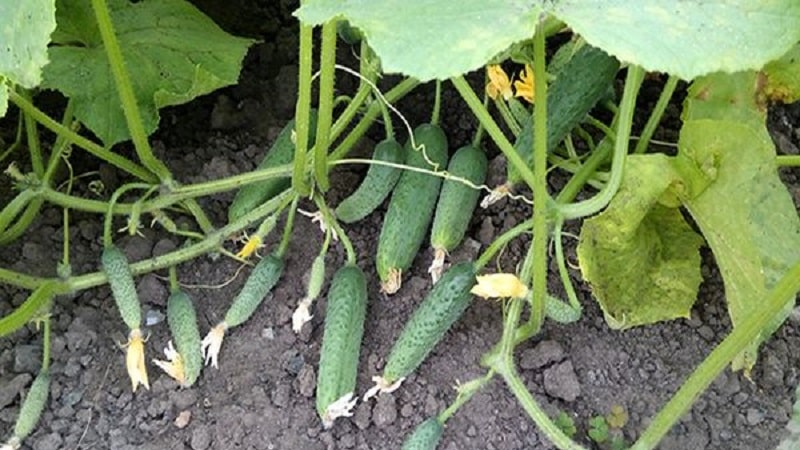
Features of cultivation and possible difficulties
To get a rich harvest, you need to know nuances of caring for emerald earrings:
- Cucumbers are watered 1-2 times every five days by rain until the first inflorescences appear. Then the soil is moistened daily, filling the soil only at the root.
- Fertilizers are applied the day after watering. This will prevent the roots from burning.
- Water and plant cucumbers when the sun is inactive. It's better to do this at sunset. On the day of planting, the soil is not moistened.
Read also:
Phoenix cucumbers with high yield and excellent taste
Early ripening high-yielding cucumber hybrid “Maryina Roshcha”
What is good about the Pasalimo f1 hybrid and why is it worth growing?
Diseases and pests
Emerald earrings have increased immunity to diseases of melons and melons. However, gardeners recommend spraying them once a week with a light pink solution of potassium permanganate as a preventive measure.
Preventive measures also include compliance with the rules of watering, planting and crop rotation. Disinfection of garden tools is no less important.
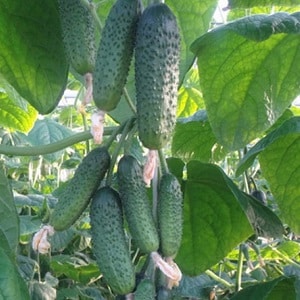 Cucumbers are often attacked by harmful insects. The following means are used to combat them:
Cucumbers are often attacked by harmful insects. The following means are used to combat them:
- To prevent plant damage greenhouse whitefly, mosquito nets are placed on the windows, and glue traps are placed on the beds. If the pest has already appeared on the plants, they are sprayed with dandelion infusion (both the above-ground part and the roots are used).
- To prevent lesions aphids, carefully weed the beds. If insects do appear on the plants, they are sprayed with a special solution. To prepare it, add 200 g of pepper minced in a meat grinder and 30 g of tobacco dust to 10 liters of water. The mixture is infused for two days, after which 2 tbsp. l. soap and wood ash.
- Against slugs set mechanical traps (wet rags or rotten wood). Another option is to scatter chemicals over the area - for example, "Thunderstorm".
Harvesting and application
Emerald earrings are harvested in June. The fruits are picked when they reach their maximum size - 10-12 cm. Some gardeners collect pickles (3-4 cm) or gherkins (6-8 cm).
The harvested crop is stored in a cool place. In this form it will remain for more than three weeks.
Emerald earrings are consumed raw. They are used for salting and pickling.
Advantages and disadvantages of a hybrid
Benefits of Emerald Earrings:
- immunity to diseases of melons;
- ease of care;
- ability to self-pollinate;
- high productivity;
- wonderful taste of the fruit.
The disadvantage is the hybridity of Emerald earrings. The seeds obtained from their harvest are not used for sowing.

Reviews
Most gardeners who have tried Emerald catkins grow this hybrid again and again. They do not require artificial pollination even in a greenhouse and have high yields.
Vasilisa, Tver: “I planted emerald earrings last year on the recommendation of a neighbor. The hybrid really surprised me. Despite the fact that I grew it in a greenhouse and did not participate in its pollination in any way, the harvest turned out amazing, tasty, plentiful and beautiful, as in the photo.The seedlings were grown in 2 stages. I planted the first at the end of May, and the second in mid-July. So I had fresh cucumbers on my table all summer.”.
Igor, Sochi: “I’ve been growing emerald earrings for three years now. The hybrid sets fruit in bouquets. The harvest is excellent both in the greenhouse and in open ground. The taste of cucumbers is excellent. They are sweet and crispy - without bitterness even at the end of summer.".
Conclusion
Emerald catkins are a hybrid that will appeal to both experienced and novice gardeners. It is not afraid of nightshade diseases and is characterized by high productivity. The main feature of cucumbers is the bouquet arrangement of the ovaries. Only female inflorescences are formed on the bushes, but the hybrid is parthenocarpic and is pollinated without the help of insects.